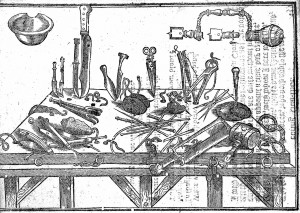In Physician, one of the writings collected under the name of Hippocrates in the fifth century B.C., the aspiring surgeon is instructed to follow the armies in order to learn the art of surgery. In times of peace, writes Hippocrates, rarely if ever, “even in a whole lifetime,” does one encounter the kinds of severe wounds that one must contend with in the heat of battle.
How true. Even today, some of the most remarkable surgical innovations have come as a result of warfare. Extraordinary advances in reconstructive surgery, for example, have been made during the Iraq war as a result of the need to treat injuries caused by roadside bombs. And, during the American Civil War, surgeons performed amputations with remarkable success.
Military surgeons must respond creatively to a wide range of new and unexpected situations. As an example, I relate this amazing tale from the Renaissance:
On a sultry day in July, 1550, soldiers in the army of the Holy Roman Empire were encamped outside the city of Mahdiya, near Tunis, nervously awaiting orders to launch a final assault on the town, a stronghold of the Turkish pirate Dragut. A Spanish officer and his companion, a surgeon in the emperor’s army, were strolling through the camp when they came upon two soldiers engaged in a heated quarrel. The men drew their swords and squared off.
The Spanish officer tried to stop the brawl, only to receive a backhand blow that neatly sliced off his nose, which fell to the ground. As the astonished officer stood with his mouth agape, bleeding profusely from the face, the surgeon calmly picked up the severed nose from the dirt. “Holding it in my hand,” he later recounted, “I pissed on it, and having washed it off with urine, I attached it to him and sewed it on firmly, medicated it with balsam, and bandaged it.” When he untied the wound, the surgeon later recalled, “I found it was very well attached again, and everyone marveled at it.”
The quick-witted surgeon, Leonardo Fioravanti, would go on to become one of the most controversial figures of the Italian Renaissance. He repudiated conventional medicine and created an alternative medical movement—the “new way of healing”—that made him history’s first celebrity doctor.
Fioravanti is the subject of my latest book, The Professor of Secrets: Mystery, Medicine and Alchemy in Renaissance Italy, which relates many more tales of surgical innovations. A scholarly work written for general readers, The Professor of Secrets is the story of a Renaissance healer whose “marvelous” cures and talent for self-aggrandizement earned him the adoration of the people, the scorn of the medical establishment, and an enduring reputation as one of the age’s most colorful figures.
The cold analytical language of the Hippocratic corpus quoted at the beginning of this post barely conceals the irony behind the suggestion that warfare, whose aim is to kill and maim, should be such fine training for the surgeon, whose art is that of healing. Yet behind that counsel lies the understanding that in learning any art, whether carpentry, tennis, or playing the cello, practice alone makes perfect. The trouble is, in the education of a surgeon, the novice has to practice on people.






